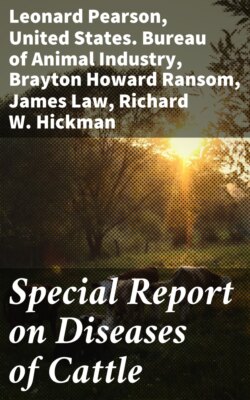Читать книгу Special Report on Diseases of Cattle - Lowe - Страница 31
На сайте Литреса книга снята с продажи.
IMAGINARY DISEASES (HOLLOW HORN; LOSS OF CUD; WOLF IN THE TAIL).
ОглавлениеIt would appear quite in place here, in connection with the diseases of the stomach and bowels of cattle, to consider the three old fallacies or superstitions known by the above names, since these names, whenever and wherever used, seem to be invariably applied to some form of digestive derangement or disease having its origin in the stomach and bowels.
Hollow horn.—In the first place it should be noted that the horns of all animals of the ox tribe are hollow. The horn cores are elongations of the frontal bones of the skull, and the frontal sinuses, which are the larger of the air spaces of the head, are prolonged into the horn cores. When a cow is sick, if the horns are hot it is an evidence of fever; if they are cold it indicates impaired circulation of the blood; but these manifestations of sickness are to be regarded as symptoms of some constitutional disorder and do not in themselves require treatment. The treatment should be applied to the disease which causes the abnormal temperature of the horns. The usual treatment for the supposed hollow horn, which consists in boring the horns with a gimlet and pouring turpentine into the openings thus made, is not only useless and cruel, but is liable to set up an acute inflammation and result in an abscess of the sinus.
Loss of cud.—The so-called loss of cud is simply a cessation of rumination, frequently one of the first indications of some form of disease, since ruminants stop chewing the cud when they feel sick. Loss of cud is a symptom of a great many diseases, and when it is detected it should lead the observer to try to discover other symptoms upon which to base a correct opinion as to the nature of the disease from which the animal suffers. No local treatment is required.
Wolf in the tail.—This term also seems to be vaguely applied to various disturbances of the digestive function, or to some disease which is in reality in the stomach or bowels.
